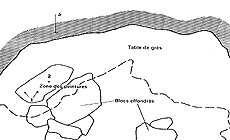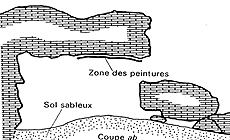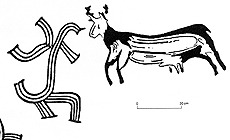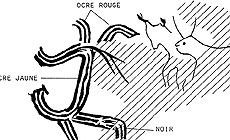|
|
 |
 |
Country: |
France |
Locality: |
Fontainebleau |
|
 |
Region: |
Seine-et-Marne |
Area: |
|
|
 |
 |
|
|
|
|
| |
 |
Environment & Surface |
 |
 |
 |
|
Open-air
Shelter
Cave
Portable
Megalithic
|
Geography: |
Abri ouvert au sud dans un plateau gréseux, dans la forêt de Fontainebleau. La grotte, profonde de 30 m à l'origine, comprenait trois chambres. Elle fut en grande partie détruite par des carriers en 1870. |
Proximity: |
La grotte se situe à 2 km au nord de Montigny-sur-Loing. Plusieurs sites paléolithiques (non ornés) sont connus dans cette région (entre autre les stations périgordiennes de Hault-le-Roc et Long-Rocher). |
|
 |
Geology: |
grès stampien |
Surface: |
couverte par la végétation et la suie de feux de camp. |
|
|
|
|
 |
 |
|
|
|
|
| |
 |
Art |
 |
 |
 |
Description: |
Engravings
Paintings
Painted engravings
High or low-relief
Sculpture
Les ouvres pariétales sont constituées par deux groupes de "macaronis", en tracés digitraux triples ou quadruples, réalisés à l'ocre rouge et jaune, et deux figures peintes de cervidés, difficiles à lire. L'animal supérieur serait un faux, exécuté en 1962.
|
Figures: |
total number 2
2 cervidés, 2 tracés digitaux
|
|
 |
Chronology: |
Palaeolithic
Epipalaeolithic - Mesolithic
Neolithic
Copper Age
Bronze Age
Iron Age
Roman
Middle Age
Modern
Unknown
H. Breuil attribuait les deux figures à la fin du Magdalénien, ou au contraire au 1e cycle, aurignaco-périgordien. La difficulté de lecture empêche aujourd'hui toute attribution stylistique précise. Les fouilles, anciennes et peu méticuleuses, ont livré un matériel allant du Magdalénien à l'époque romaine.
|
Notes: |
|
|
 |
 |
|
| |
 |
Bibliography |
 |
|
|
|
|
| |
 |
Conservation |
 |
 |
 |
Status: |
Public
Private
Park
Classified site
|
Risk: |
Les peintures sont très altérées, et leur lecture rendue quasi impossible à cause du développement végétal et du noir de fumée qui les recouvre. |
|
 |
Conservation: |
Good
Quite good
Mediocre
Bad
|
Intervention: |
Les premiers vestiges archéologiques sont découverts en 1874 par C. Durand ; ils entraînent une fouille menée par E. Doigneau, E. Chauquet et A. Vallot. Une fouille plus importante est pratiquée à partir de 1891 par E. Thomas-Marancourt, mais avec une méthode non adaptée. Les peintures ont été aperçues en 1947 par H. Poupée, et présentées à la Société préhistorique française en 1949. H. Breuil a vu les peintures peu après leur découverte. Le site est classé Monument historique le 10 janvier 1953. Le relevé des peintures est publié en 1960 par J.L. Baudet, qui affirmera ensuite (1981) que le second animal est un faux réalisé en 1962. Un second relevé est réalisé en 1975 par le Groupement archéologique de la Région de Fontainebleau. En 1980, de nouvelles recherches sont menées par J. Poignant pour éclaircir la lecture des ouvres. |
|
 |
 |
|
|
 |
By |
 |
|
| |
| Record n. 345 / 807 |
No commercial use is allowed. Specific © is mentioned in the captions or owned by each Author or Institution |
|
| |
 |
EuroPreArt, European Prehistoric Art, is a web-based archaeological project funded by the European Union which aims to establish a lasting data-base of European prehistoric art documentation, to launch the base of an European institutional network and to contribute to the awareness of the diversity and richness of European Prehistoric Art.
It is proposed by: Instituto Politécnico de Tomar (IPT, Portugal),
CUEBC - European University Centre for Cultural Heritage (Italy - Europe),
Consejo Superior de Investigaciones Científicas (España),
Asociación Cultural Colectivo Barbaón (España),
Université de Liège (Belgique),
Gotland University College (Sverige),
University College Dublin (Eire),
Cooperativa Archeologica Le Orme dell'Uomo (Italia),
Study Centre and Museum of Prehistoric Art of
Pinerolo (Italia),
The European Centre for Prehistoric Research in the Alto Ribatejo (Portugal),
ArqueoJovem - a youth NGO (Portugal).
|
|
|
|
 |
|
 NEW: Alpine rock paintings
NEW: Alpine rock paintings



